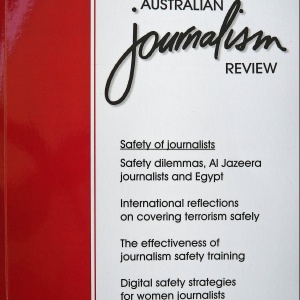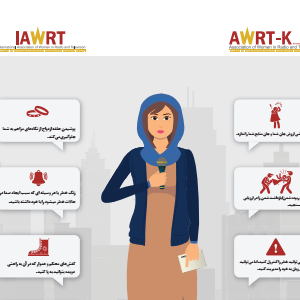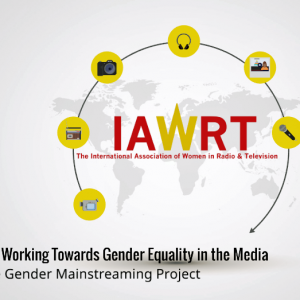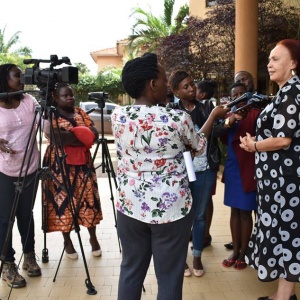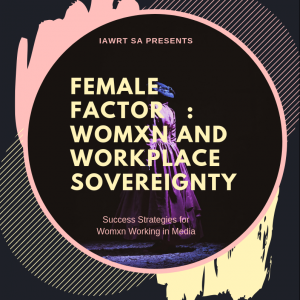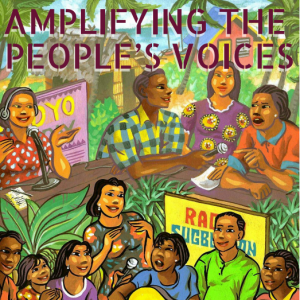The IAWRT Digital Safehouse (DSH) pilot project in the Philippines will build an online platform that will link journalists’ safety programs and efforts.
Across the globe from Uganda to Kurdistan to the USA, IAWRT members were involved the 16 days of activism against gendered violence.
In Uganda statistics indicate 49% of women and 41 % men believe a man is justified in beating his wife for specific reasons. 56% of women aged 15 to 49 years have experienced physical violence at least once since the age of 15.
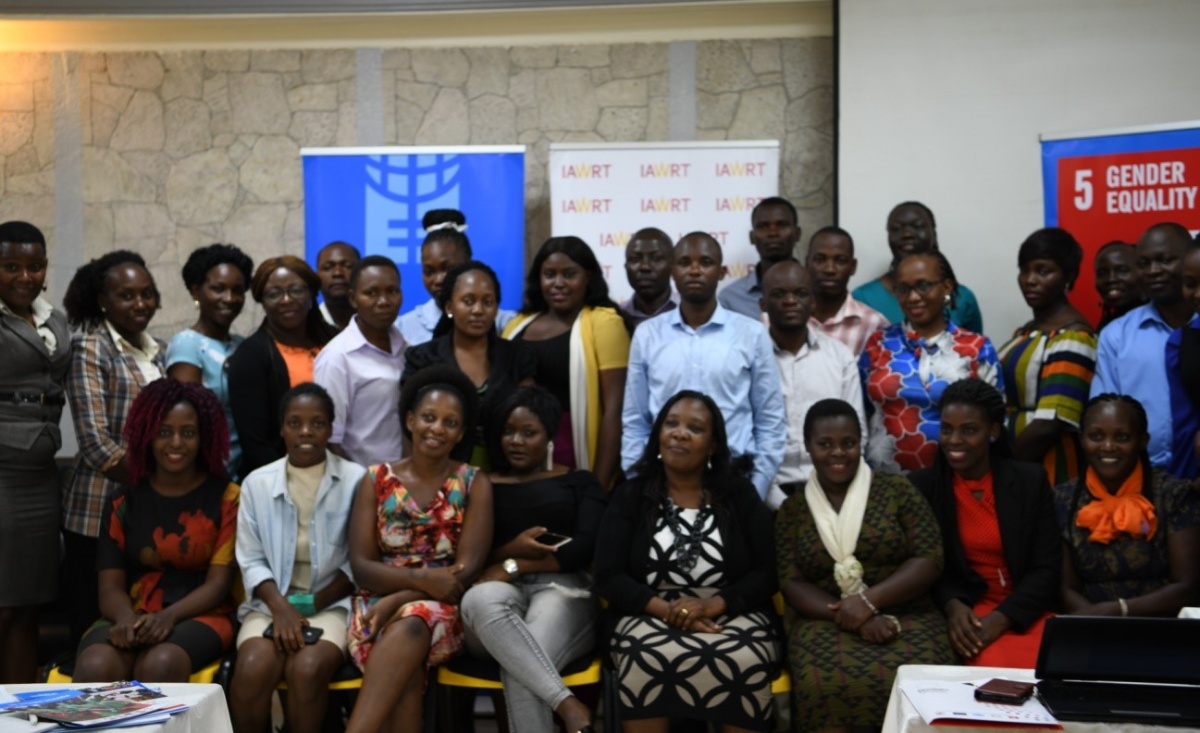 The Ugandan statistics are representative of the real lives of women and girls in that country and the IAWRT Ugandan Chapter believed that media has the responsibility to demystify and personify these statistics. This is needed for the public to fully understand the true meaning of violence against women and the related negative impact on lives.
The Ugandan statistics are representative of the real lives of women and girls in that country and the IAWRT Ugandan Chapter believed that media has the responsibility to demystify and personify these statistics. This is needed for the public to fully understand the true meaning of violence against women and the related negative impact on lives.
Against this background the IAWRT chapter, in partnership with UNWOMEN thought it right to mobilize the media to discuss the role of media in influencing the public response towards the fight against gender-based violence against women and girls.
As one of the activities to contribute to the 16 days of Activism against Gender Based Violence, a media engagement was held in Kampala on the 27th of November 2019.The full day engagement that aimed at creating public awareness in the fight against GBV, brought together 65 participants including editors, senior journalists, bloggers and other stakeholders from like-minded organizations.
The purpose was laying a foundation for the media to fully understand and actively contribute to creating public awareness on ending violence against women and girls.
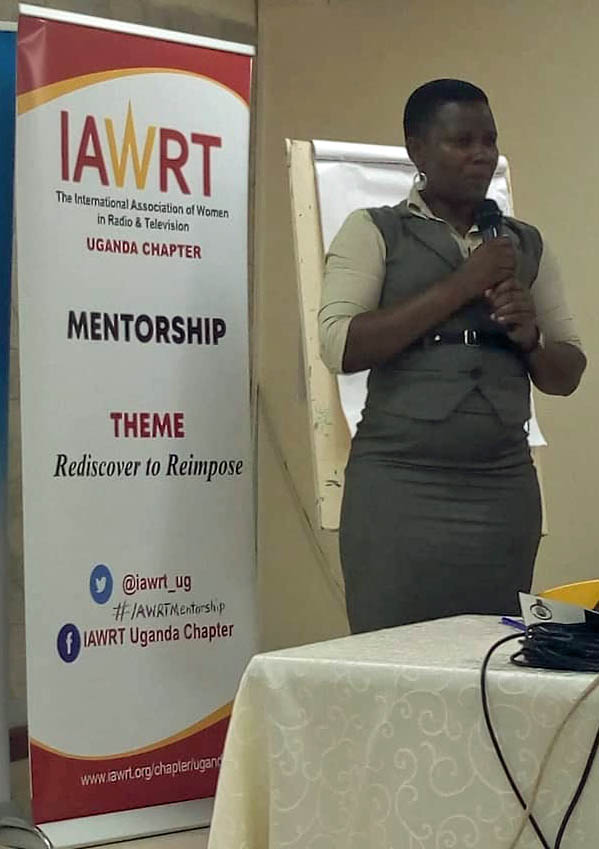 Nankwanga Eunice Kasirye, the chapter Head IAWRT Uganda, made the opening remarks with an emphasis on the day’s specific objectives, of briefing the media on 16 days of activism activities, enabling participants to obtain a clear understating of the 16 days of activism, upskilling the media to identify story ideas during the 16 days of activism and lobbying for media promotion of positive portrayals and fair treatment of women. She highlighted the vital role the media has in raising awareness of GBV by setting the agenda with the power to dictate public perception.
Nankwanga Eunice Kasirye, the chapter Head IAWRT Uganda, made the opening remarks with an emphasis on the day’s specific objectives, of briefing the media on 16 days of activism activities, enabling participants to obtain a clear understating of the 16 days of activism, upskilling the media to identify story ideas during the 16 days of activism and lobbying for media promotion of positive portrayals and fair treatment of women. She highlighted the vital role the media has in raising awareness of GBV by setting the agenda with the power to dictate public perception.
Eunice challenged the media and individual journalists to seek out knowledge and information on gender reporting since it is a sensitive and delicate subject which requires full authority and confidence to take on.
“The subject of gender violence calls for ethical professional reporting, requiring fairness, honesty and accuracy. Otherwise, a lack of such values may instead seem to condone violence against women and girls.”
Without thorough knowledge of gender equality, Eunice says it is literally hard for a reporter to come up with a captivating story pitch to the editorial team therefore making it almost impossible for gender related stories to find space in bulletins and publications.
She called upon IAWRT members, wherever they are, to take centre stage in promoting, lobbying and setting the pace to achieve a gender sensitive Media. That should start with individual responsibility to avoid negative stereotypes of women in media reports and ensuring positive portrayal is emphasized.
Supporting one another as media women is one other approach to attaining positive portrayal of women in the media, women in different media organization structures should deliberately help each other to be better at their tasks through continuous improvement and positive criticism, and more women should meaningfully take up positions at the decision tables.
Eunice challenged women to desist from trivial differences, backstabbing, intrigue and blackmail but concentrate on building a formidable professional, reliable and objective force to make, enforce and oversee critical decisions that affect the space of a woman in the media.
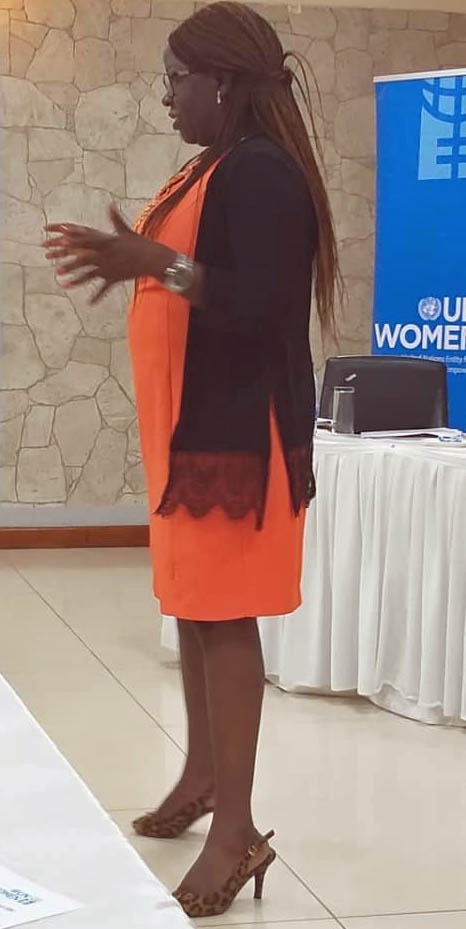 Evelyn Letiyo, a program specialist with the UN women in Uganda discussed the connection between gender violence against women and power. According to Evelyn, people with power are never abused but those without power tend to accept some levels of abuse just to survive and be in the ‘good books’ of those in power.
Evelyn Letiyo, a program specialist with the UN women in Uganda discussed the connection between gender violence against women and power. According to Evelyn, people with power are never abused but those without power tend to accept some levels of abuse just to survive and be in the ‘good books’ of those in power.
“Gender Based Violence are acts that result or are likely to result into physical, sexual harm to women including threats of such acts, coercion, arbitrary deprivation of liberty, whether occurring in public or private life”
“Violence starts slowly with subtle nonphysical acts until it graduates into physical violence, sometimes escalating into permanent damage or death. Consistent threats should not be ignored because with time they are put into action” She said.
Evelyn Letiyo cautioned the media against being judgmental while reporting incidences of GBV, saying understanding the context of the entire story is more important than rushing to file a story because in that process the media end up hurting the innocent persons.
She says violence against women manifests in a number of ways easily seen but the violence extends beyond the physical to psychological and mental forms of violence.The abusers also move with trends in technology taking advantage of the internet and its diversity.
“Such continuous manifestation of violence against women calls for continuous media refresher courses and capacity building interventions to ensure the media helps in the fight against GBV with a deliberate approach to protect the victim and helping them to survive and live past the abuse.”
Martin Ninsiima the Communication and Advocacy Specialist at UN Women Uganda, called upon the media to deliberately champion the positive portrayal of women at all times. “The media should be gender sensitive in preparing content such selecting panellists for shows and programs, choosing sources for key stories, internal media house recruitment and management structuring among other approaches”. Martin emphasized that the media has the power to influence general perceptions of issues of concern therefore should use the same power to promote positive portrayal of women.
He encouraged the journalists to come up with well thought out story pitches on GBV and said that UN women would be able to support the production of such stories.
Counsel Carol Idembe, the GBV program Manager at the inter Religious Council of Uganda, appealed to the media to use a survivor-centred approach that seeks to empower survivors by putting them at the core of the healing process while reporting on GBV issues. According to Counsel Carol, the journalist following up on a GBV story should recognize that each person is unique, reacts differently to GBV, has different strengths, resources and coping mechanisms, has the right to decide who should know about what has happened to them, and what should happen next.
“GBV is a manifestation of power inequality, and reporters should desist from imposing their own perspective to avoid disempowering survivors.”
Dealing with GBV survivors in a survivor-centred manner involves prioritizing their best interest, and applying the guiding principles of safety, confidentiality, respect, and non-discrimination, Carol emphasized.
Resolutions and Observations:
- Need for train and sensitization. Not many journalists know what GBV is.
- Increase the number of stories written on GBV
- Journalists should know how to pitch stories on GBV.
- Networking with stakeholders to ensure there’s consistent coverage of GBV
- Need to set up a fund dedicated to enhancing coverage of GBV stories
- Set up a forum for journalists where quarterly or bi quarterly meetings can be held to help them access and improve on GBV reporting.
(source of statistics: Uganda National Household Survey report (DHS).
IAWRT Iraq-Kurdistan Activities to end Violence against Women
By Binay Shorsh
Under the 16th days campaign against violence against women, which began on November 25 and continued until mid-December, members of the IAWRT-Iraq-Kurdistan chapter organized different activities aimed at for reducing violence against women and raising social awareness.
On November 30, Awaz Abdulla participated in a short movie festival about gender-based sexual violence in Erbil. This was supported by Internews.
In the festival eight short movies were presented by different directors from the provinces of Iraq and the Sulaymaniyah governate.The project goal was to challenge society’s reaction towards survivors of sexual and gender-based violence by supporting journalists and women human rights defenders to focus on sensitive issues through coordinated reporting and advocacy.
On November 24, Lava Kurd prepared and presented the Shaqam program at Radio Nawa for November 25 for this year the international day to end violence against women.
According to the program, female employees was a motto for this year and during the program Hannah Shwan – women’s rights activist and Avin Nasreen, a journalist, discussed the media’s role in reducing violence against women and spreading awareness in society.
Dlsoz shafiq khalaf, a journalist and activist organized awareness sessions, and visited a number of girl’s schools
She participated in different activities to explain how to reduce violence in all forms against women.
The Awareness and Capacity Development Organization(Awan) launched the Women’s Center for Protection and Legal and Social Guidance.
The center will provide comprehensive protection services for abused women and girls. It aims to improve access to help for women and girls who are victims or survivors of gender-based violence. The center is headed by Manar Al-Zubaid, and has an advisory body consisting of expert volunteers in coordination with the relevant professional unions as well as the Diwaniyah Police Command and the Health Department.
On December 8, a group of civil organizations, condemned the advice of some Kurdistan clergymen advising avoiding women riding in taxis without a man.
The group included ministers, journalists, activists, clerics, including our IAWRT Kurdestan members, At the time when groups around the world included Iraq and Kurdistan, are busy participating in campaigns against violence against women and for gender equality, in the Kurdistan region these clerics were advising women to not ride a taxi if they are with a male driver. This is clear evidence that gender is different, and this is creating a fear of the taxi driver, further restricting women’s freedom.
Shno Osman Participated in a TV program about the media’s role in reducing women victims and spreading awareness in society about the fear facing women who are using social media
USA The Commission on the Status of Women/NY focused on violence against women and girls (VAWG)
By Marry Ferreira
A November gathering discussed how to use data and behavioral insights to prevent and eradicate VAWG, and the 16 Days of Activism Against Gender-Based Violence.
Ms. Houry Geudelekian, Chair of the CSW/NY, started the meeting by highlighting the Women of Distinction Award Nominations for NGO CSW64. In 2020, CSW/NY will commemorate the 25th Anniversary of the Fourth World Conference on Women, Beijing +25. In celebration, the organization will honor five women, one from each United Nations Region: Africa, Asia-Pacific, Latin America Caribbean, Eastern Europe, Western Europe, and others. More information is available on the CSW/NY website.
Daniela Philipson Garcia, Feminist Task Force, and Women’s Economic Justice Program Assistant, moderated a panel conversation with Marta Garnelo, Senior Advisor of The Behavioural Insights Team; Adra Manasi, Campaign Manager of the 16 Days Campaign at the Center for Women’s Global Leadership; Mishka Martin, Policy and Advocacy Specialist at Plan International; and Monica Meltis, Executive Director at Data Civica.
Ms. Garcia and Mishka Martin began the conversation remembering the 30th anniversary of the Convention on the Rights of the Child and the speech of the 15- years- old Millie Bobby Brown about cyberbullying, harmful practices, and bullying against girls at the United Nations General Assembly on November 20th. “I was thrilled to see Brown talking about harmful practices because girls have been strategizing against gender violence for years,” said Ms. Martin.
Focusing on adolescents and girls, Mishka Martin’s job is to research and design solutions to close the gap in policies and programs related to gender violence. “Yesterday, member states, NGOs and civil society made commitments at the United Nations headquarters in the 30th anniversary of the Convention on the Rights of the Child. But it is worth noticing that the adolescent and girls are quite invisible to those international legal frameworks. There is no mention in the Convention to gender or specific position of girls”, she said.
During the CSW/NY meeting, Ms. Martin highlighted the intersectional marginalizations that impact girls’ rights because of the gap in policies and programs. According to her, invest in international legal frameworks related to adolescents and girls, and in activists on the ground are practices that can secure their protection.
The different definitions of feminicide have also impacted public data and strategies to eradicate VAWG in Mexico. Monica Meltis, Executive Director at Data Civica, called attention to how the state’s legislations affect the prevention of femicide. “It is hard to compare the data in each state,however, we know that feminicide is not an isolated effect in Mexico. That violence is generated at home, perpetrated by partners and intensified by the presence of guns in the households”, said Ms. Meltis.
In terms of behavioral science, Marta Garnelo’s research at Behavioral Insights Team is to understand the communities’ behavior for not interfering when witnessing domestic violence. “The belief of the violence as a private matter and the lack of knowledge of how to act to help are some reasons that are preventing the community from supporting a person who is in a situation of violence,” said Marta Garnelo.
Ardra Manasi, Campaign Manager at the Center for Women’s Global Leadership, ended the panel discussion emphasizing that gender violence is a human right issue, and inviting the society to join the 16 Days Campaign.
The 16 Days of Activism Against Gender-Based Violence kicked off on November 25th, the International Day for the Elimination of Violence against Women, and ran until December 10th, Human Rights Day. It was started by activists at the inaugural Women’s Global Leadership Institute in 1991 and continues to be coordinated each year by the Center for Women’s Global Leadership.
The Journalism and Media International Center (JMIC) in Norway, is funding an Arabic Translation on IAWRT’s safety handbook for women.
JMIC is a part of the Department of Journalism studies at the Oslo Metropolitan University (OsloMet) in Norway, and the translation is part of a pilot project to include IAWRT in some JMIC activities.
This official Arabic translation is due to be published by the end of 2019. This program is financed by the Norwegian Ministry of Foreign affairs and restricted to partner countries in the global south.
As part of this programme JMIC has invited IAWRT representatives to join a October 2019 conference along with Universitas Indonesia academics to examine gender in teaching journalism and media studies
The safety handbook has also been presented to the Journalism Education and Research Association of Australia (JERRA) annual conference and a commentary about its production was featured in JERAA’s flagship publication, Australian Journalism Review, in an edition focusing on safety.
JERRA and the publisher, Intellect Books, have given permission to reproduce the article Why do we have to search for a line here and there on safety for women journalists? by Nonee Walsh, Abeer Saady (IAWRT) & Fiona Martin (Department of Media & Communications, University of Sydney)
The safety edition of the Australian Journalism Review (December 2018) is available to purchase here on Intellect Books website, and is in many university libraries.
Promoting a New Generation of Female Media Leaders
By Maryam Bahar Sadat
A ceremony held in Kabul has marked the completion of IAWRT Afghanistan’s (AWRT-K) seven-month project to enhance the skills and influence of women journalists
The event opened with discussion of the project’s impact and the ideas of speakers from the leadership of the Afghanistan Journalists Federation. The USAID Rasana project was run in cooperation with the Afghanistan Women Journalists Union (AWJU) and the Centre for the Protection of Afghan Women Journalists (CPAWJ).

During the ceremony, the second-tier leaders of each organization which participated in different voluntary activities were awarded for their dedication to serving women journalists.
Pic: From Left to Right: Lida Ahmadi, Hajira Karimi, Laila Noorani, IAWRT Project Manager, Maryam Bahar Sadat, Shabnam Popalzai, Malala Maiwand and Freshta Faizi.
The Rasana Project with Internews involved two phases, the first, developing gender policy for the Federation of Afghan Media Associations and Entities and implementation of that policy, and secondly, the training of second-tier leaders.
The first activity was aimed at strengthening the presence and influence of women in the media within the federation, which is made up of 15 journalist unions and support groups.
 By firstly hosting a federation meeting, AWRT-K raised awareness of members about gender inclusion and facilitated discussion on gender inclusivity in federation policies along with strategies for implementation of the developed strategy.
By firstly hosting a federation meeting, AWRT-K raised awareness of members about gender inclusion and facilitated discussion on gender inclusivity in federation policies along with strategies for implementation of the developed strategy.
- An action plan for implementation of gender policy within the federation was developed and it is being followed up in each federation meeting until it’s practiced.
- AWRT-K worked with federation members to include gender inclusive policy in federation regulations and to ensure the implementation of policy across the board
- AWRT-K gained the commitment of federation members to implement the gender inclusive policy and developed a hotline email for complaints from women journalists all over Afghanistan which will be led by the three women journalist organizations (AWRT, AWJU, CPAWJ).
- Established a Gender Focal Point position to monitor the activities of the federation from a gender perspective. Ms. Farida Nikzad the Director of CPAWJ was assigned in cooperation with AWRT-K to act as a Gender Focal Point for the federation.
In the second activity, AWRT-K worked to develop second-tier leadership within women journalist support groups to ensure better representation of women as well as to sustain efforts within the federation to improve the status of women journalists.
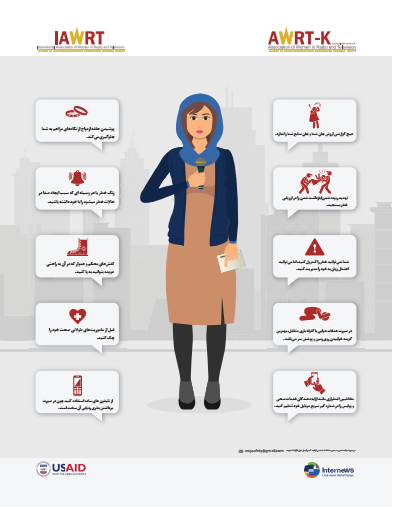
- Through conducting a workshop on women journalist leadership skills, along with identifying the challenges of women journalist in Afghanistan. We selected six young women journalists as second-tier leaders from Kabul, Parwan and Nangarhar.
- A strategy for capacity building of second-tier leaders – developing their knowledge and leadership skills in the media sectors by assigning them small research projects, and through attending different programs, training and seminars, including short English courses.
- Two-page safety guideline brochure and a poster were developed by AWRT-K in local languages which will be disseminated all over Afghanistan for women journalists and media entities.
Pic right: IAWRT Afghanistan safety guideline poster for women journalists in the Dari language, with advice on how to keep tehmselves safe by following some small points, including wearing sensible footwear, a wedding ring to repel unwanted advances, staying in contact with employers and when to take shelter.
Other coverage
IAWRT Handbook on Working Towards Gender Equality in the Media: IAWRT & the Gender Mainstreaming Project, written by Greta Gober, has been launched in Norway at an event entitled, #MeToo-and now what? organised by IAWRT Norway. The book written by Greta Gober, showcases IAWRT members’ experiences and best practices for working towards the advancement of gender equality in media.
Based on the on-the-ground running of such initiatives by IAWRT Kenya, Uganda, Tanzania, South Africa and India. the booklet is now available in our publications section.
It showcases the vastly different ways in which IAWRT chapters worked towards those aims through efforts or strategies with film, radio and television women. Some initiatives were in consultation with media outlets, and most included training, mentoring, and sharing of knowledge to enhance the advocacy of women’s rights Click here for a visual presentation of the GMP project and the handbook in brief.
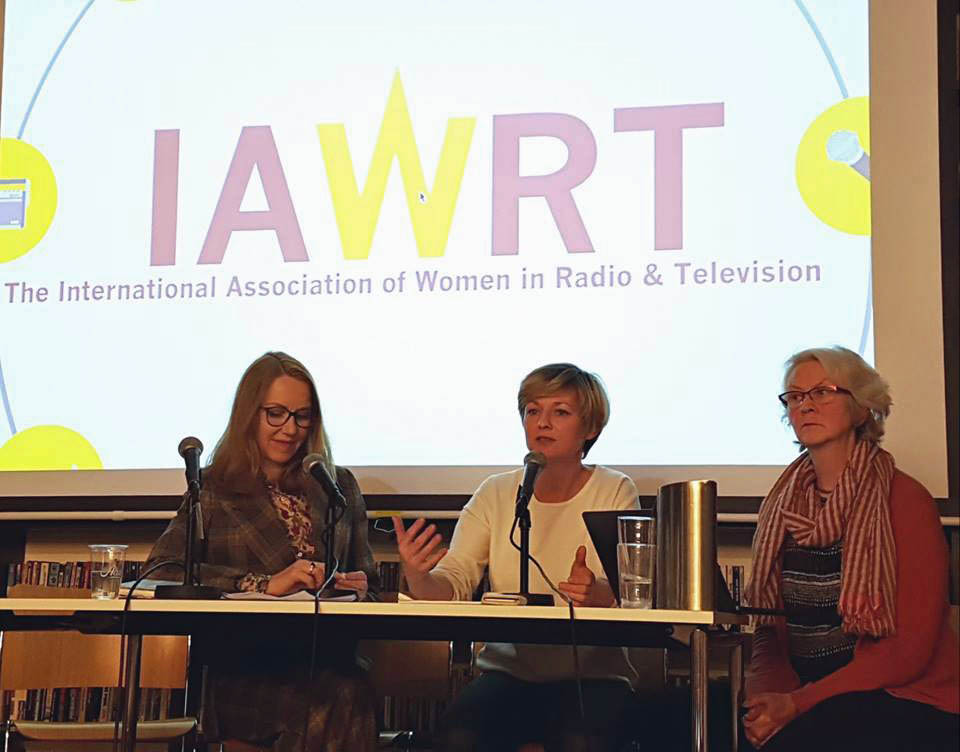 “We [IAWRT] hope it will inspire many of you, our colleagues in the so-called global North, to learn from these examples” Greta Gober says, “but also that it will encourage us to continue sharing experiences of our collective efforts to make gender equality in the media a reality!”
“We [IAWRT] hope it will inspire many of you, our colleagues in the so-called global North, to learn from these examples” Greta Gober says, “but also that it will encourage us to continue sharing experiences of our collective efforts to make gender equality in the media a reality!”
The Norway launch heard from a freelance photojournalist Marte Vike Arnesen and Professor Kristin Skare Orgeret who presented their research findings on how the #MeToo movement and debate have unfolded in Norway and played out in Norwegian media. Greta Gober says the Norway gathering was another example of sharing experiences of working towards gender equality in the media.
“I wish us all more occasions to meet and celebrate our small and large victories,” she said.
The handbook is structured around the two Gender Mainstreaming studies that IAWRT conducted in 2014 and 2015 – the Gender Mainstreaming in Broadcasting (GMB) Survey available here, which revealed how harassment was one factor in reducing the number of women who remain in media workplaces – and the Gender Equality and Social Justice (GE) Monitoring which looked at representation of women and marginalised groups in programs aired by public broadcasters.
The handbook is divided into two parts, as suggested by the UNESCO Gender-Sensitive Indicators for Media
- Actions to foster gender equality in media organizations
- Actions to foster gender-fair portrayal in media content
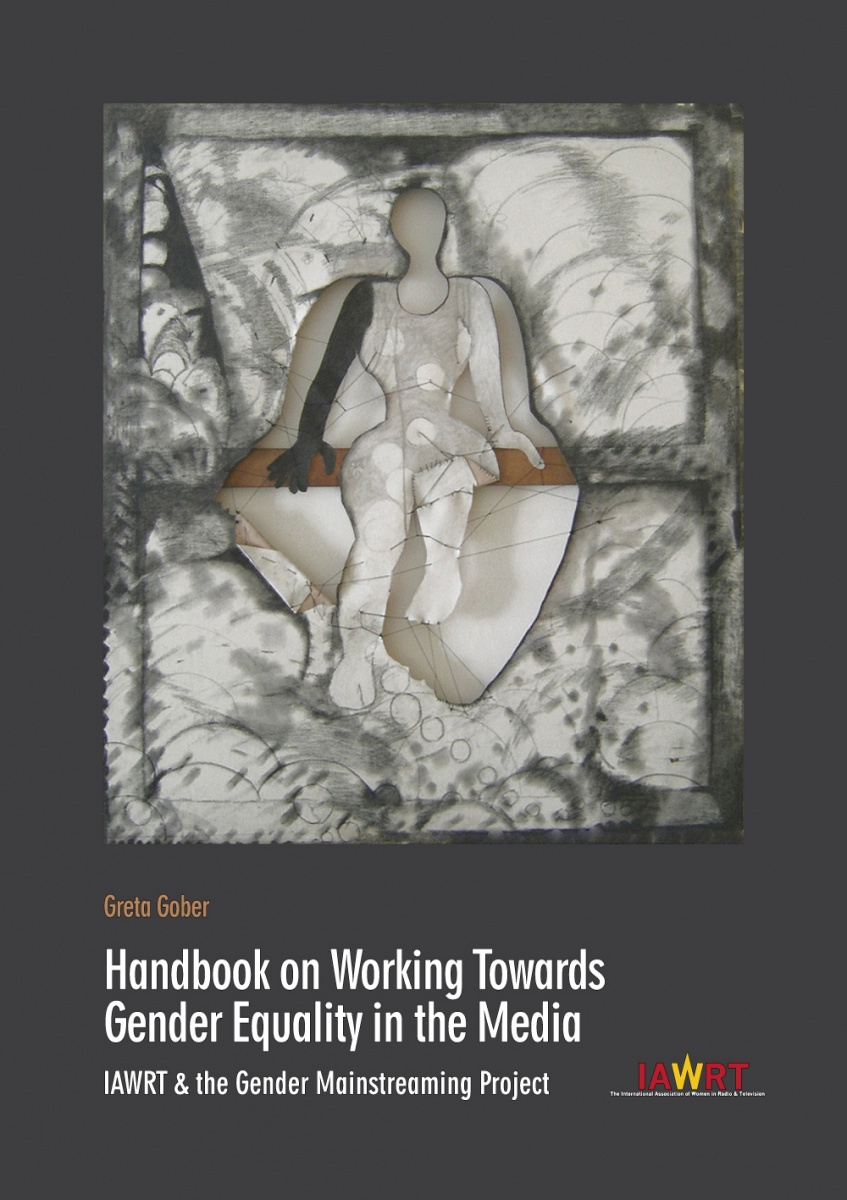
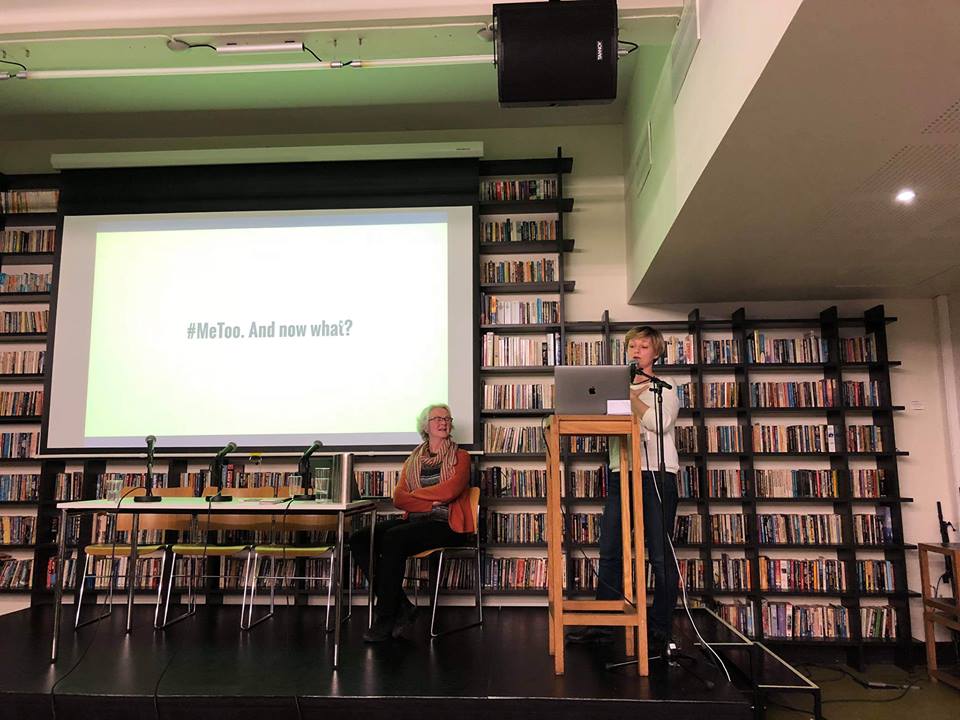 The work presented in the handbook begins with countries in which the Gender Mainstreaming Project was first launched in 2014, and covers strategies used until 2018.
The work presented in the handbook begins with countries in which the Gender Mainstreaming Project was first launched in 2014, and covers strategies used until 2018.
The most recent phase of the GMP project in 2018-9 has focused on broad gender equity issues, equal employment and safety for women in the media industry. More details here.
Greta Gober says the handbook will be of interest to individuals and organizations concerned with gender equality in the media who are looking for inspiration on how to advance that objective. “Media organizations, media and journalists’ unions and associations, academics and research centers and institution should find this handbook of interest.”
“As a member of the Global Alliance on Media and Gender (GAMAG) IAWRT hopes that this handbook will inspire our colleagues in the global North to learn from these examples and be prompted to continue sharing their own experiences of our collective efforts to make gender equality in the media a reality” she said.
The GMP project was made possible by the support of Forum for Women and Development (FOKUS) and UNESCO-Norway.
Ugandan journalists are supported to re-evaluate their potentials and weakness, identify opportunities and become gender ambassadors
By Nankwanga Eunice Kasirye
The media statistics about women in terms of representation and relevance in Ugandan media are pathetic.
 Keno Lilian is an IAWRT Uganda Re discover to Re impose mentor. Keno Lilian is an IAWRT Uganda Re discover to Re impose mentor.
Lilian believes that making serious preparations for every assignment as a journalist puts one in charge of their own job and a master of every task. “it should be a key attribute for every female journalist for every task assigned, such will automatically lift the female journalist above the basic mediocre positions they seem to want to settle for.” |
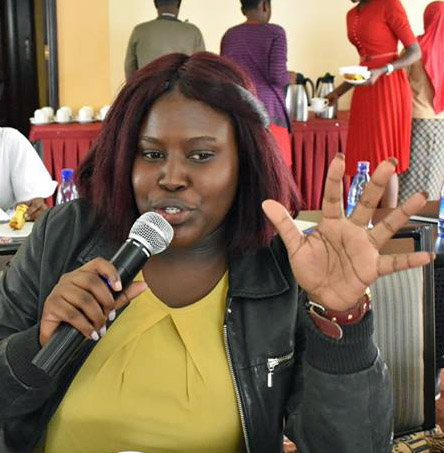 Madrine Nabukera, is one of the IAWRT Uganda team of mentees Madrine Nabukera, is one of the IAWRT Uganda team of mentees
She is grateful to hav been selected as the opportunity came at a time when she desperately needed guidance on her career path. Despite being good at almost everything in a television newsroom, Madrine wants focus and mastery to ably grow and develop into the prestigious and excellent female journalist she always dreamt of being. |
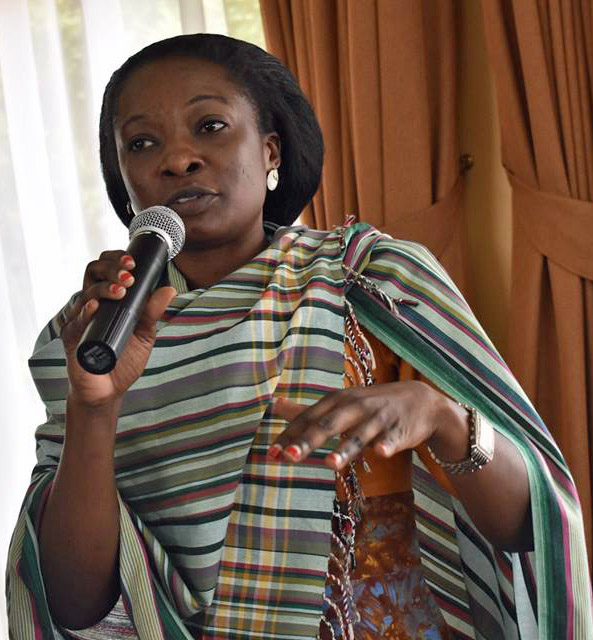
Nankya Slyvia is another of the IAWRT Uganda mentors. She believes it is an obligation for every journalist to adhere to the professional code of ethics. “The code of ethics booklets should be part of every newsroom or media outlet, for daily reference, for it is important to have a set of good ethical procedures.” |
So a robust collaborative approach is required to achieve fair and better representation.
The 2014 Uganda National Census report says women account for 51% of the total national population. Despite that advantage in numbers the media does not reflect this balance in terms of news sources and positive portrayal. According to the research by African Centre for Media Excellence (ACME) on media coverage for the 2016 Uganda general elections, only 20% of women were quoted as news sources in election stories between September 2015 and May 2016. The Global Media monitoring report 2015 indicates that only 28% of Ugandan women were news subjects with the majority linked to subjects rated as ‘unserious’.
The undesirable trends in media research statistics prompted IAWRT Uganda to engage with news editors and senior journalists on the agenda of gender mainstreaming in the newsroom; that gave birth to the IAWRT-Uganda Re discover to Re impose mentorship initiative.
The initiative is geared towards building a sustainable national pool of gender mainstreaming ambassadors through mentorship. The Re discover to Re impose Mentorship Project championed by IAWRT Uganda is a progressive initiative that brings together journalists, students, institutions of learning, representatives of like-minded organizations or personalities and policymakers, to build a sustainable pool of gender media ambassadors.
Run under the theme; Re discover to Re impose, media practitioners, especially women, ought to get back to the drawing board and re-evaluate their potentials and weakness, identify their opportunities to promote gender-fairness and the threats that lie ahead in their struggles to be better positioned.(A SWOT analysis) This would ensure gender sensitivity in internal media houses, human resources development, gender sensitive media content and elimination of negative portrayals of women in the media.
The initiative started with a pioneer selected group of thirty ambassadors that included ten mentors and twenty mentees to champion the gender cause in the media. The pioneer ambassadors were systematically selected by IAWRT-Uganda’s executive.
Building a sustainable pool of Gender Mainstreaming ambassadors through mentorship requires re discovering one’s potential to re impose for opportunities, thus it was imperative for the team to understand what gender and equity means in relation to the media alongside the legal frameworks that complement the strides towards equality.
Therefore, the Re discover Re impose gender mainstreaming workshop was held in Kampala in Dec 2018 to introduce the pioneer ambassadors to gender as a concept in relation to the media as well as the legal perceptive. Separate pre-orientation engagements with the mentees and mentors were held for feedback and development of a needs assessment tool to steer the mentorship process. Through career profiles which individuals made in their SWOT analysis, mentors were partnered up with mentees according to career needs and strength. This process of engagement is ongoing
During the orientation workshop, the IAWRT Uganda chairperson Nankwanga Eunice Kasirye, explained that Gender Mainstreaming project activities are focused on mentorship under the theme: Re discover to Re impose. She demystified the theme; saying that the re discovers are calls for re-evaluation of personal potentials, through undertaking a personal SWOT analysis to help better position themselves; then Re impose into the space of positive impact or opportunities.
Eunice challenged fellow female journalists to stop self-pity and to stand firm, to face their challenges with the determination to try again and again until the credible and impactful presence of women, at all levels, becomes real
Eunice says that if women re discover their potential and reposition to re impose into positions of power and authority then the negative portrayal of women in the media will automatically be censored.
Prof. Maggie Kigozi is the patron of the IAWRT Uganda chapter, she challenged the female journalists to work together and support each other, to build credible networks and determine to look out for female achievers to put their stories in the limelight. Professor Maggie says through mentorship, each one of us is able to build up into becoming a better person without losing out on anything
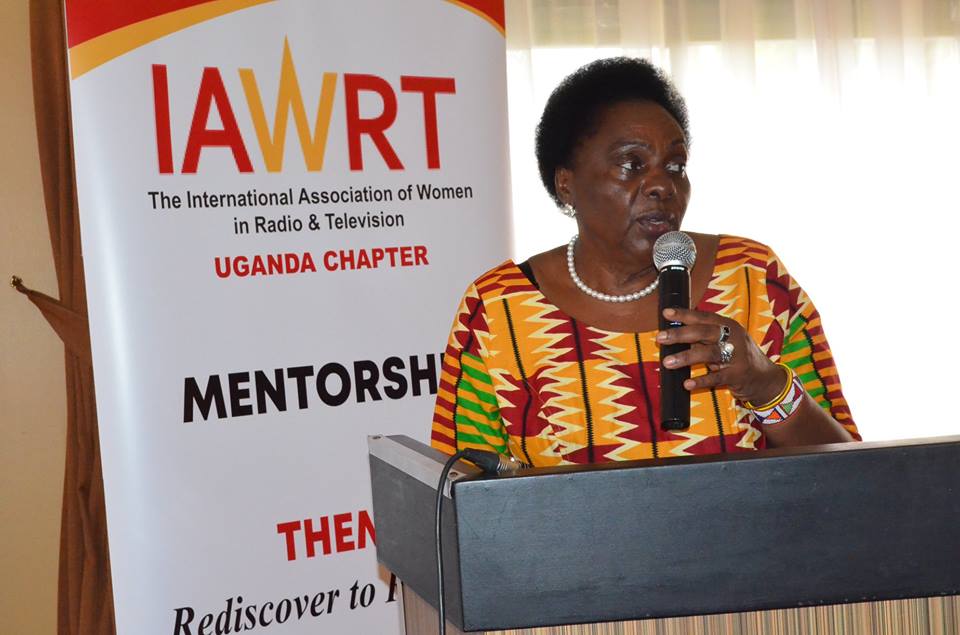 The Minister in charge of General Duties at the office of the Prime Minister, Mary Karooro Okurut, challenged the female journalists and pioneer gender mainstreaming ambassadors to set a fair precedent, by balancing up stories without bias before publishing them. She says it is more profitable to create working partnerships with sources than making them enemies through bad unrealistic reporting.
The Minister in charge of General Duties at the office of the Prime Minister, Mary Karooro Okurut, challenged the female journalists and pioneer gender mainstreaming ambassadors to set a fair precedent, by balancing up stories without bias before publishing them. She says it is more profitable to create working partnerships with sources than making them enemies through bad unrealistic reporting.
Karooro says the theme Re discovers to Re impose is self-challenging, for it demands open mindedness and a truthful and fair self-assessment to help one understand their current career position before leaping to the next level.
She says it is a theme that will help build a sustainable strong force that enables improvements to gender equity in both media organizational structure and content. The minister challenged IAWRT to look out for funding to carry out a survey on the exact position of the Uganda media in terms of gender equity and portrayal.
 Professor Nassnga Gorreti, of Makerere University, who is the first full professor of journalism and communication in Uganda. says IAWRT mentorship should be able to improve positive portrayal of women in the media, the number of women in decision making positions within media houses and open up opportunities for career excellence. “The IAWRT mentorship should also be able to create a working relationship with institutions to integrate journalism schools into the agenda of gender mainstreaming through a sustainable approach”. she said.
Professor Nassnga Gorreti, of Makerere University, who is the first full professor of journalism and communication in Uganda. says IAWRT mentorship should be able to improve positive portrayal of women in the media, the number of women in decision making positions within media houses and open up opportunities for career excellence. “The IAWRT mentorship should also be able to create a working relationship with institutions to integrate journalism schools into the agenda of gender mainstreaming through a sustainable approach”. she said.
Caroline Idembe is a human rights lawyer in Uganda, she facilitated a workshop on the need to understand the legal redresses and limitations to be able to re impose as female journalists in the positions that matter. Carol says the UN agenda 2030 which calls for the use of government funds for gender equity and women’s rights cannot be fully monitored without the media being well skilled and equipped with the legal and policy frameworks that obligates the government to meet its part of the bargain.
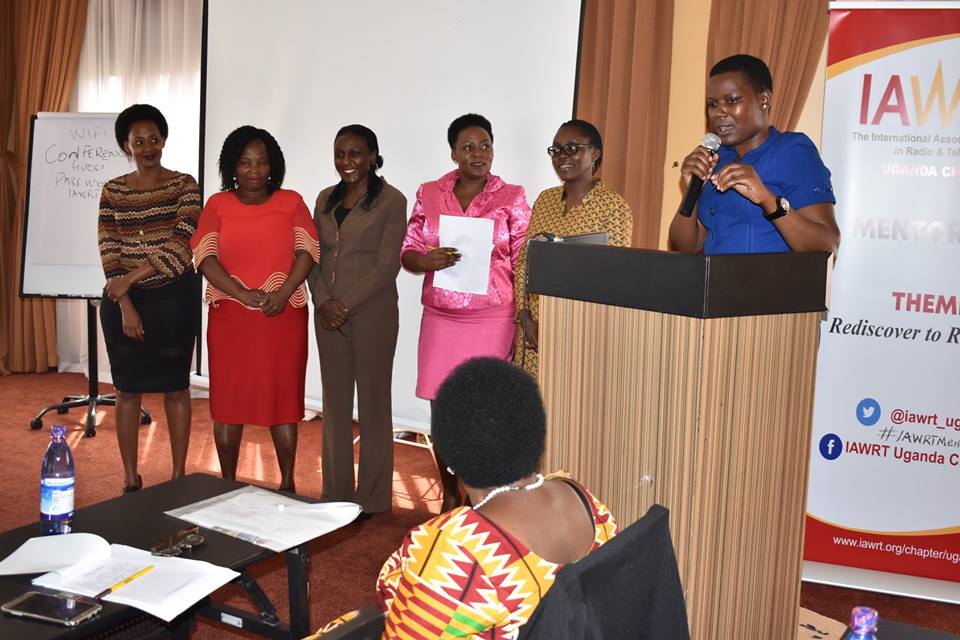
Therefore, we require continuous in-depth training for the IAWRT mentees. We want the pioneer team to form a well informed force in the media which can be used as a reference point.
The intention is ensure that the pioneer ambassadors become trainers of trainers as they become well versed with gender and the law.
So the first orientation workshop was introductory to the gender concept and the legal frameworks for our ambassadors to light the candles where ever they work or operate from.
The Re discover to Re impose Mentorship Project under the championed by IAWRT Uganda is a progressive initiative that brings together journalists, students, institutions of learning, representatives of like-minded personalities or organizations and policymakers to build a sustainable pool of gender media ambassadors.
Media coverage
‘Portrayal of women, girls in media should change’
speaker kadaga commends iawrt for fighting gender inequality in media
Young journalists trained to represent female colleagues
Women journalists from across Afghanistan have been introduced to gender studies on Afghan women journalists and some have received internships with practical training in representing females within the journalists’ union.
by Maryam Bahar Sadat
At a one-day workshop entitled, Challenges of Afghan Women Journalists and the Solutions, a group of 25 young women journalists from capital cities and provinces of Afghanistan got together in groups to suggest solutions to the issues faced by women working in the country’s media.
They workshopped three questions which we identified for them:
1. The current situation and the participation of Afghan women journalists in society, compared to male journalists. How supportive was the system for women, as compared to men?
2. What are the challenges of Afghan women journalists?
3. What were the expectations of our participants from Afghanistan’s existing media associations, unions and organizations?
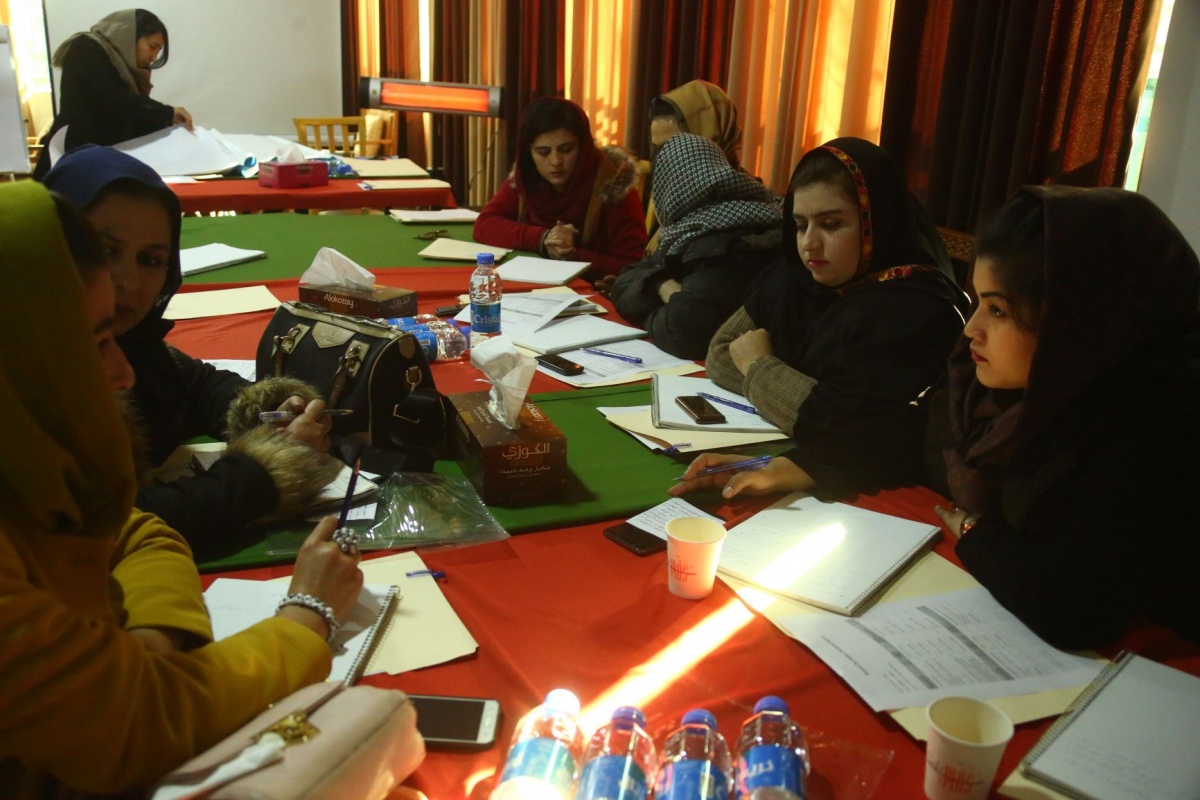 One main purpose of this workshop was to introduce the objectives of IAWRT, and the young journalists were quite excited about the activities which IAWRT is doing all over the world and they showed their interest in volunteering and being a part of a great network.
One main purpose of this workshop was to introduce the objectives of IAWRT, and the young journalists were quite excited about the activities which IAWRT is doing all over the world and they showed their interest in volunteering and being a part of a great network.
Currently we are in the phase II of Rasana Project with Internews. The first phase was to develop gender policy for the federation and in this phase, the focus is mostly on the implementation of that policy in the federation and the training of second-tier leaders.
At the end of workshop, six of the participants were selected as second-tier leaders to receive practical training in representing women in the Afghan Journalists Federation and others were selected as representatives of IAWRT Afghanistan for their provinces.
Over seven months, these six young journalists will learn leadership skills, along with learning the practical work and procedures inside the federation such as; conducting monthly meetings of the federation, advocacy for other women in media and arranging different national and international meetings for the federation. From time to time they will participate in digital security, public speaking, communication, safety and other related training.
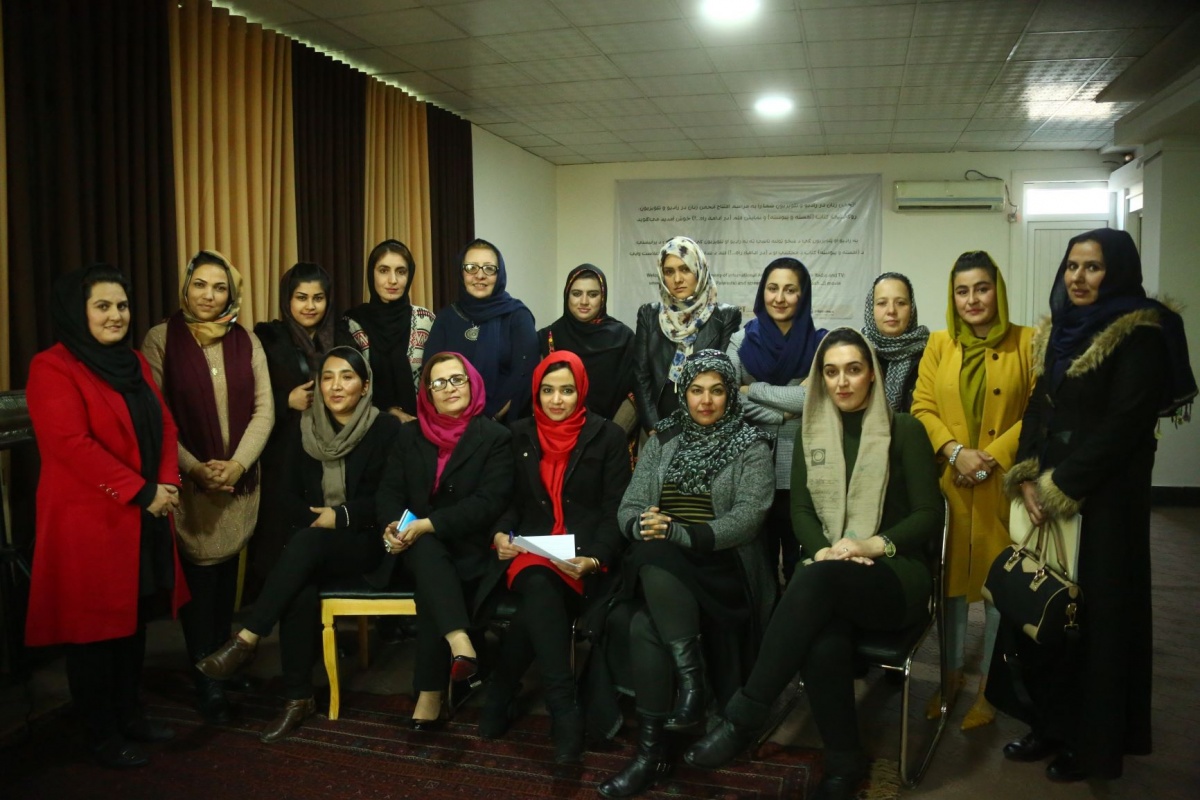
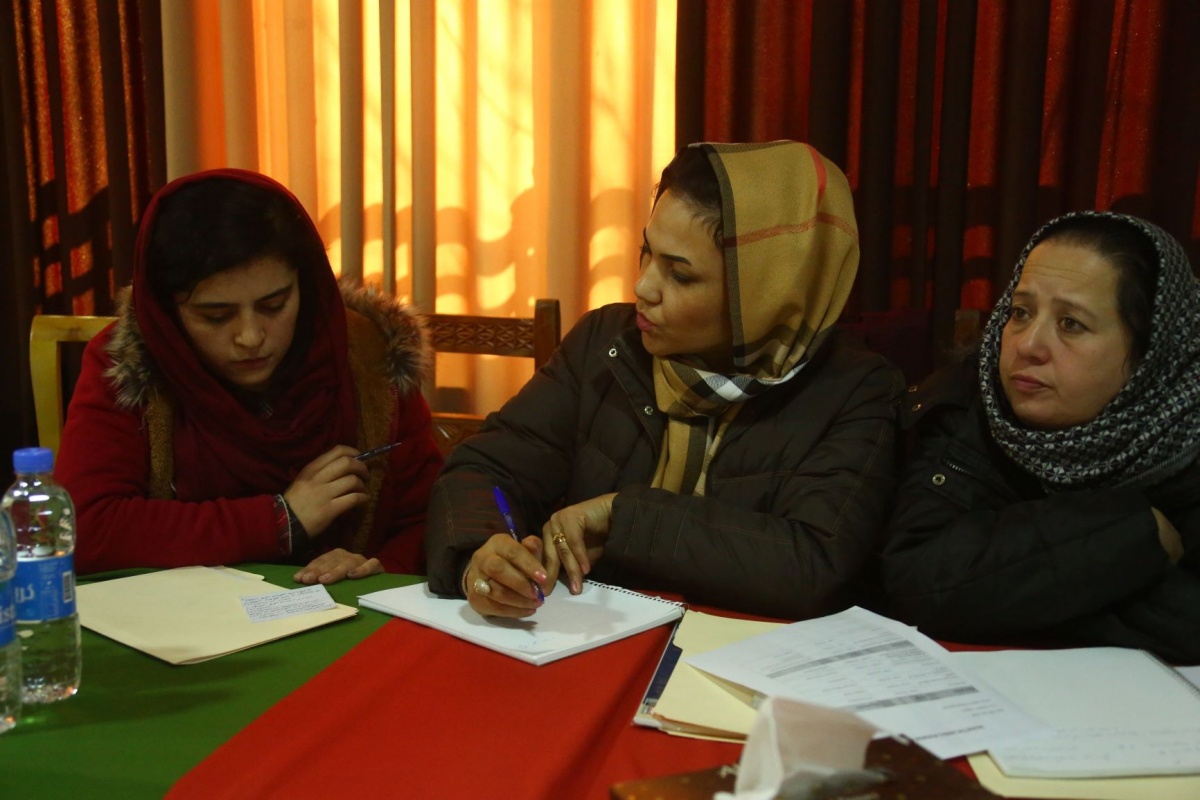
- Making women safe to do the best stories covering gender-based violence – Norway.
- Examining the extent and scope of sexual harassment in Cameroonian newsrooms
- Strategies for achieving gender equality in Iraq-Kurdistan media organizations
- Digital safety of journalists in Kenya
- Workplace strategies for women in South African film
- #Metoo Nepal for media students & improving women’s representation on media
- Uganda creating a pool of Gender Mainstreaming Ambassadors.
- Sexual harassment prevention in the Indian film industry
The Gender Mainstreaming Project (GMP) supported by FOKUS and UNESCO-Norway, is the largest activity conducted by IAWRT in 2018 and into 2019. details here. A new handbook on best practices for fully integrating gender perspectives into media policy – focusing on southern and eastern Africa and India – will be released in 2019. Locally tailored workshops, training, demonstrating and assessing best practices were run by chapters around the world in 2018.
Uganda
Re Discover to Re Impose – Building a Sustainable Pool of Gender Mainstreaming Ambassadors by Nankwanga Eunice Kasirye
Building a lasting pool of gender mainstreaming ambassadors through mentorship. requires re discovering one’s potential to re impose for opportunities to create a gender-fair environment in newsrooms and on the media. The Re discover to Re impose gender mainstreaming workshop n Kampala in Dec 2018 introduced the pioneer ambassadors to gender as a concept in the media, as well as the legal perspective.

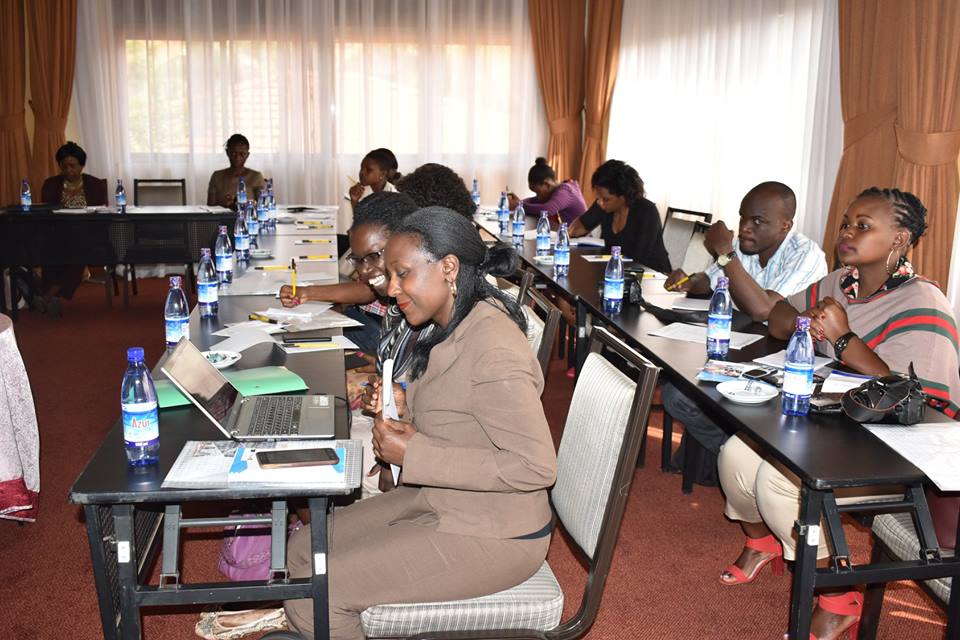 The undesirable trends in media research statistics – where only 20% of Ugandan women were quoted as news sources in election stories and only 28% of Ugandan women were news subjects – mostly lighter topics – prompted IAWRT Uganda to engage with news editors and senior journalists about gender mainstreaming in the newsroom.
The undesirable trends in media research statistics – where only 20% of Ugandan women were quoted as news sources in election stories and only 28% of Ugandan women were news subjects – mostly lighter topics – prompted IAWRT Uganda to engage with news editors and senior journalists about gender mainstreaming in the newsroom.
That gave birth to the IAWRT-Uganda’s Re discover to Re impose, mentorship of gender mainstreaming ambassadors. A pioneer group of ten mentors and twenty mentees will champion the gender cause in the media.
Through mentorship, media practitioners, especially women, get back to the drawing board and re-evaluate their potentials and weakness, identify their opportunities and the threats that lie ahead in their career struggles. Women then moving into the space of positive impact or opportunities, or positions of power and authority can reduce the negative portrayal of women in the media.
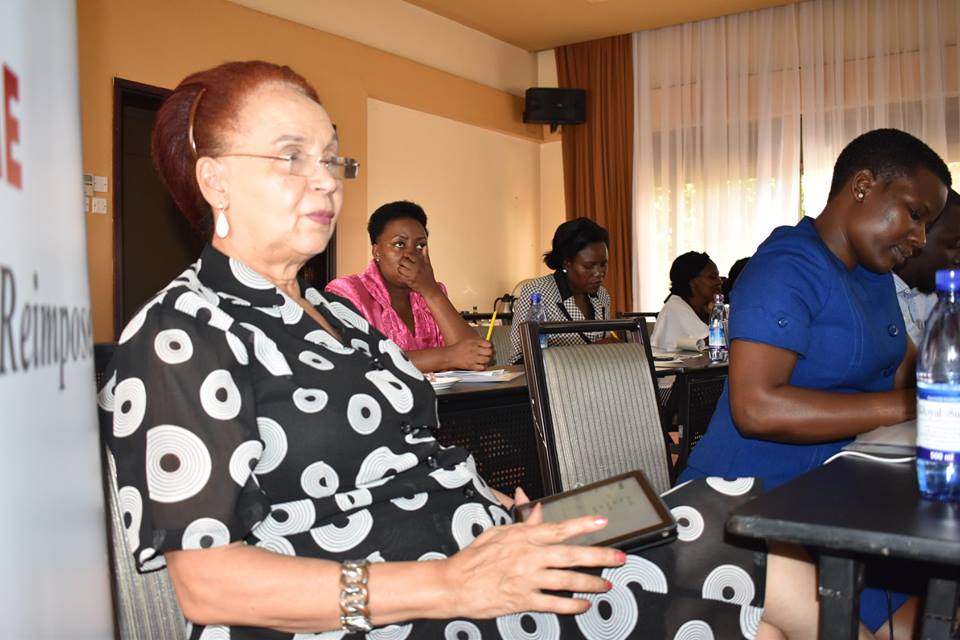
Prof. Maggie Kigozi, the patron of the IAWRT Uganda chapter, challenged the female journalists to work together and support each other, to build credible networks and determine to look out for female achievers to put their stories in the limelight.
Uganda’s first Professor of Journalism, Nassnga Gorreti, of Makerere University, says IAWRT mentorship should be able to improve the positive portrayal of women in the media, the number of women in decision making positions within media houses and open up opportunities for career excellence.
Caroline Idembe, a human rights lawyer, explained the need to understand legal redresses and its limitations, in order to gain job positions that matter. She says the UN agenda 2030, which calls on government funds to be spent for gender equity and women’s rights, needs to be fully monitored by a media which is well skilled and equipped with the legal and policy frameworks.
IAWRT-Uganda’s intention is to ensure that the pioneer ambassadors become well versed with these concepts in order to become trainers of trainers. We want the pioneer team to form a well informed force in the media which can be used for reference. We require continuous in-depth training on the same for our ambassadors to light the candles whereever they work or operate from.
South Africa
Female Factor: Women and Workplace Sovereignty – Success Strategies for women in the field, on sets, online, in radio and in newsrooms by Makganwana Mokgalong
The South African chapter’s focus with the GMP has always been to simplify things: To make it all about what the everyday woman working in media can grasp and apply in their day to day roles. So in early December, at Sonke Gender Justice we held an all-day dynamic workshop for a primary target audience of young women and other established practitioners. Katlego Nakedi a feminine empowerment coach led a powerful session of raising personal awareness around fear and how women can transcend their fear in order to master their expression. She shared tools and practices that women can use to resolve their fear and stand for themselves in the workplace and in life.
Zoe Ramushu a legal consultant, activist and producer and representative of www.swiftsa.org.za, shared the work that Sisters Working in Television and Film (SWIFT) is doing for women in TV and film. They’re doing research around harassment and sexual abuse in the industry. This research is key in calling for protective measures for women on sets. Zoe made the women aware that they can call a SWIFT representative who can help them file a case and offer support by following up to see that the perpetrator is brought to book. SWIFT is also working on industry guidelines to make safety officers mandatory on sets.
Some participants had trauma from abuse and a sense of powerlessness in an environment where disciplinary measures for perpetrators aren’t as stringent as they are in traditional work environments. However, the learning demonstrated how women can find power in the moment of abuse to stand up, speak out and push back when it is safe to do so. Some of the women reported that they now see how they could have better handled some of the abusive situations they’ve had to endure.
I am a screenwriter by trade, and my session showed two films to open up a discussion around characters, story and language. They were from the South African National Film and Video Foundation, Female Filmmaker Slate – A Groom’s Price and Ganesh Falling – very different works that illustrate that the female story isn’t as monolithic as mainstream film makes it out to be, that women from different backgrounds can have different narratives.
We focused on creating awareness around diversity and not trying to compress women’s stories into one story. What also became stark was how women bring their oppression into their craft, not from an enlightened perspective but from past trauma. What came out of this session was an affirmation that all stories are valid and agreement that how we want to be seen and heard as women is not perpetuating what continuously disempowers us. Click for full story.
Norway
“Many of the best stories covering gender-based violence are done by women journalists, However, women journalist themselves face safety threats that can risk their numbers in the journalistic field” by Kristine Ramm, Norway

Abeer Saady, the Vice President of IAWRT says this often in her training workshops, as she did in Olso in early November. As a part of the Gender Mainstreaming Project (GMP), Saady, from Egypt, gave a workshop at the OsloMet University in early November.
Abeer is one of IAWRT’s sparkling jewels, and a big asset to our organisation. She travels the word giving safety training workshops of different durations, often without getting paid, always promoting IAWRTs name. Her skill as a media consultant and safety trainer is widely recognized and appreciated. She shares from her own experience as a war correspondent with 28 years of professional experience in covering conflict zones within the Middle East, Africa and Asia. This time in Norway she addressed her advice to female journalists covering conflict zones or reporting on sensitive gender issues.
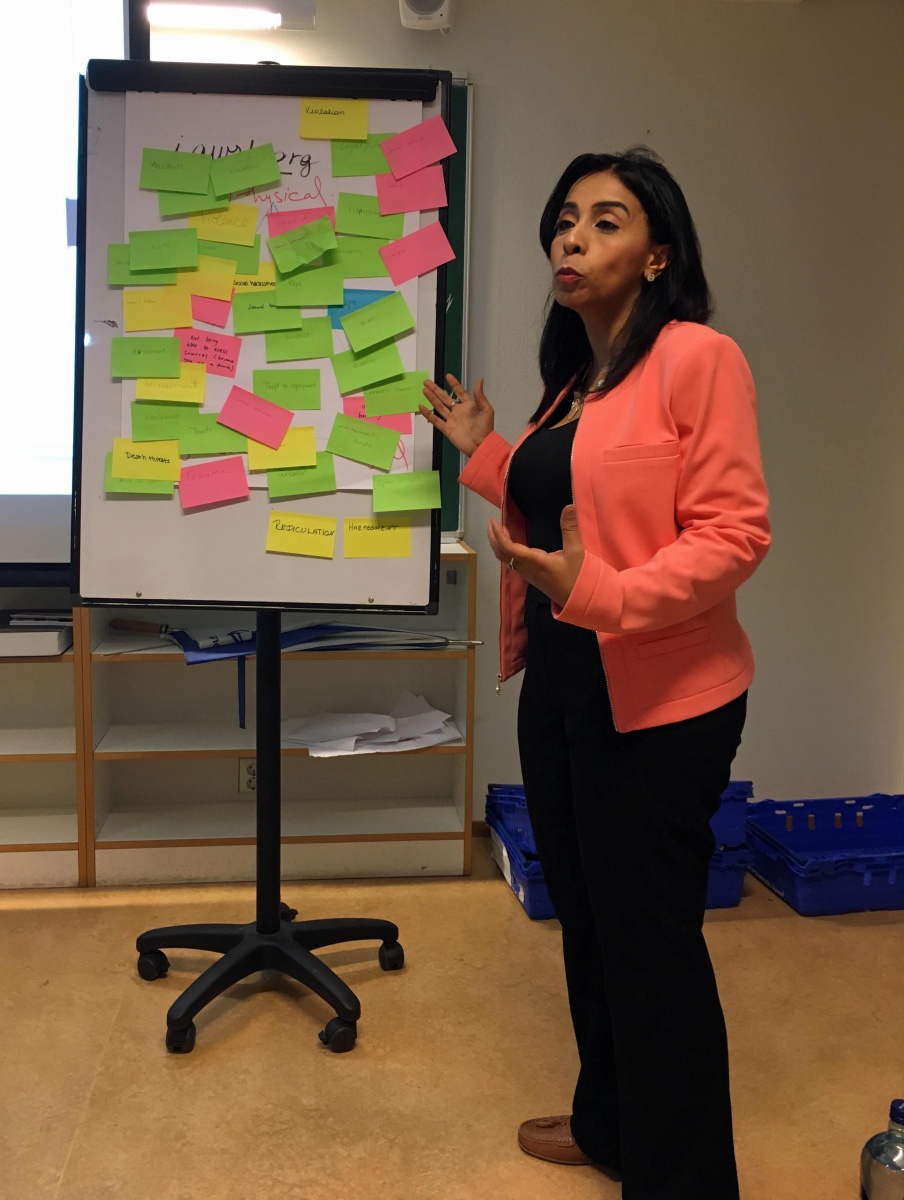
Some of her practical advice: Keep your social media sites clean, never lie: Keep private items off your public profile; Do not share information that can be used to harm you or your close ones; consider having two Facebook profiles; Be sure that your passwords differ and not contain obvious combinations; Never post that you are about to enter a conflict zone.
Participants received hands-on advice about precautions when covering crowded events and demonstrations. Even though this advice can be read in the IAWRT safety handbook for female journalists, Abeer’s advice and examples become somewhat more realistic when demonstrated face-to-face, combined with examples from real life cases.
As she often does in her workshops, we were facilitated into role plays, to engage us in realising good and bad practices when interviewing victims of accidents or violence. These exercises give participants good hands-on experience about the ethical responsibility journalists must respect in our sources in vulnerable situations. As explained in the handbook these practices are also a safety measure to protect the mental health of the reporter herself.
With additional funding from UNESCO-Norway, a handbook based on earlier phases of IAWRT’s GMP surveys, research and workshops to identify best practices for gender equality in the media from India and southern Africa is now being written by Greta Gober. In this video, researcher Ann Mabel Sanyu explains the project.
The handbook is due to be launched at IAWRT-Norway’s second GMP event IN 2019.
Cameroon
End sexual harassment in the media in Cameroon #PressforProgress #Metoo #Hearmetoo #237stopsexualharassment #stopGBV by Becky Bissong
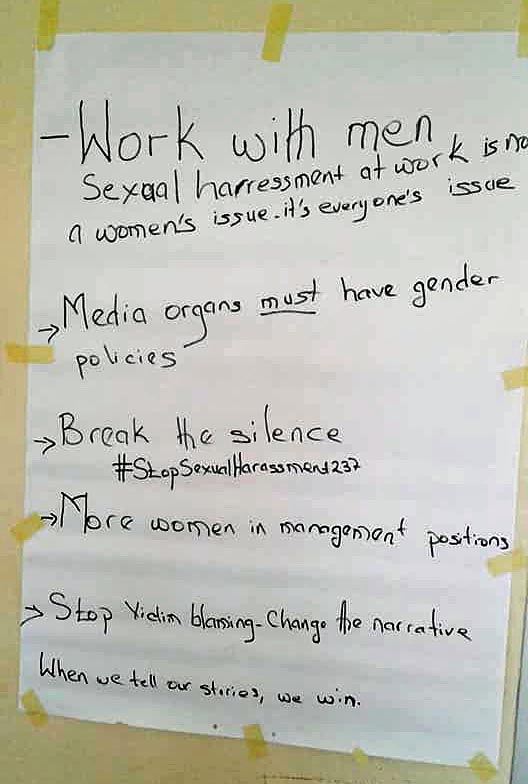
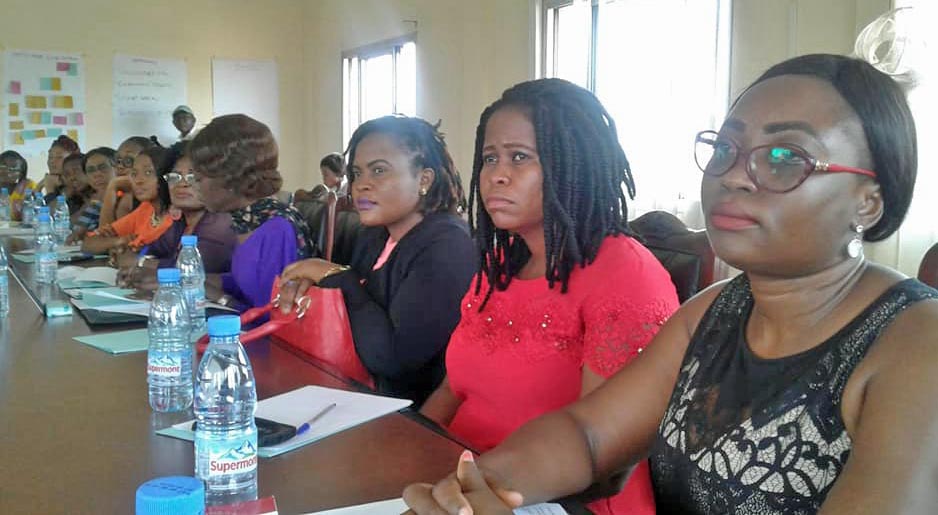 Over 50 media women from public and private media enterprises in Cameroon attended a workshop that formed a plan of attack on sexual harassment in their workplaces.
Over 50 media women from public and private media enterprises in Cameroon attended a workshop that formed a plan of attack on sexual harassment in their workplaces.
The scope and depth of the problem in newsrooms was outlined by Comfort Mussa, a journalist and activist. With 8 out of 10 women in media saying they had been harassed, it was glaringly clear that it is so prevalent in Cameroon’s media, that it is generally considered “normal”.
Comfort regretted the fact that despite those numbers, even media women do not speak out against such gender based violence because of the fear of stigmatisation and ignorance of the law. She noted that the situation was getting worse because of the lack of gender policies in media enterprises.
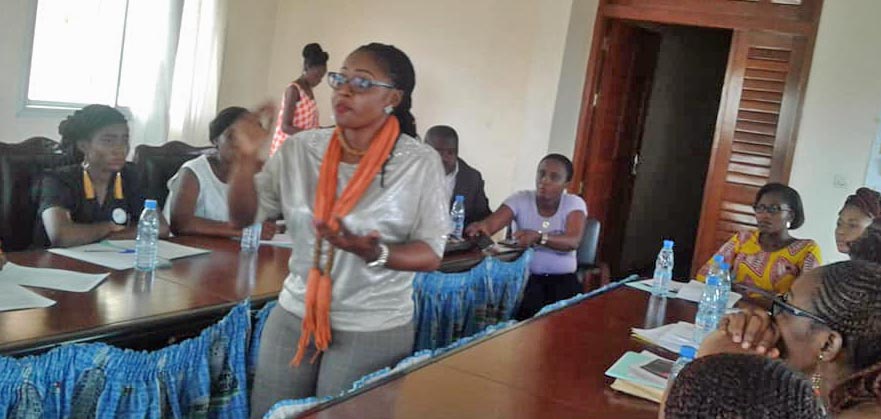 There was extensive discussion on the many overt and covert forms of sexual harassment in newsrooms and its impact on careers through stress and trauma and the labelling of media women who do not give into it. Florence Mvondo Mbezele, from the Ministry of Communication shared information on laws and international conventions, which are available to be used to uphold and protect media women’s human rights.
There was extensive discussion on the many overt and covert forms of sexual harassment in newsrooms and its impact on careers through stress and trauma and the labelling of media women who do not give into it. Florence Mvondo Mbezele, from the Ministry of Communication shared information on laws and international conventions, which are available to be used to uphold and protect media women’s human rights.
Media women at the gathering resolved to continue collecting valid data on the extent of the problem, to encourage support networks for women who speak out, and to campaign and work to ensure the development and implementation of gender policies to check sexual harassment and enforce respect for the journalists’ code of ethics in Cameroon.
Iraq
Debate: Eliminating Gender Discrimination in Media Binay Shorsh reports from Sulaymaniyah
As part of the global 16 Days of Activism Against Gender-Based Violence Campaign, which began on November 25, the IAWRT Iraq-Kurdistan chapter organized a special seminar on gender equality in media organizations, which debated the status of women in the media and the problems they faced because of their gender. It also highlighted women’s media capabilities for achieving their goals.
Prominent women journalists and media reporters in the Kurdistan Region attended at the Hotel Titanic in Sulaymaniyah City in early December. Lava Kurda a spokeswoman for IAWRT-Iraq said, “We have gathered today to participate in dialogue and consultation on achieving equality between women and men in media organizations and to talk about our role as women in achieving equality and renunciation of violence and discrimination, through our work and by demonstrating our competence and ability to work.”
According to the discussion, many media women do not support each other, especially when they achieve high positions. Susan Anwar, a journalist, said there needs to be a return to basics before defending media women’s rights, ‘We basically do not understand what our rights are … the majority of women fight them instead of supporting them,” she said.
One of the participants, Shna, a teacher and journalist, suggested that women journalists needed to raise awareness about their rights, duties and about what violence is. “I work in Metro Center, unfortunately, women never complain about taking their rights, while only men and young people come to claim their rights.”
On the other hand, the journalist Rawshan said: “We have to separate the political and Islamic consciousness and the policies that have been exposed to the Kurdish people throughout history, Kurds have no state of their own; the orientalists who visited Kurdistan spoke admiringly about the role of Kurdish women in the community. To get out of the cycle of Islamic stereotypes and customs and traditions imposed on us, we need to work to support us being strong Kurdish woman and coming out of the framework of customs and traditions imposed on us by other people.”
Kenya
One day workshop on digital safety of journalists by Cecilia Maundu

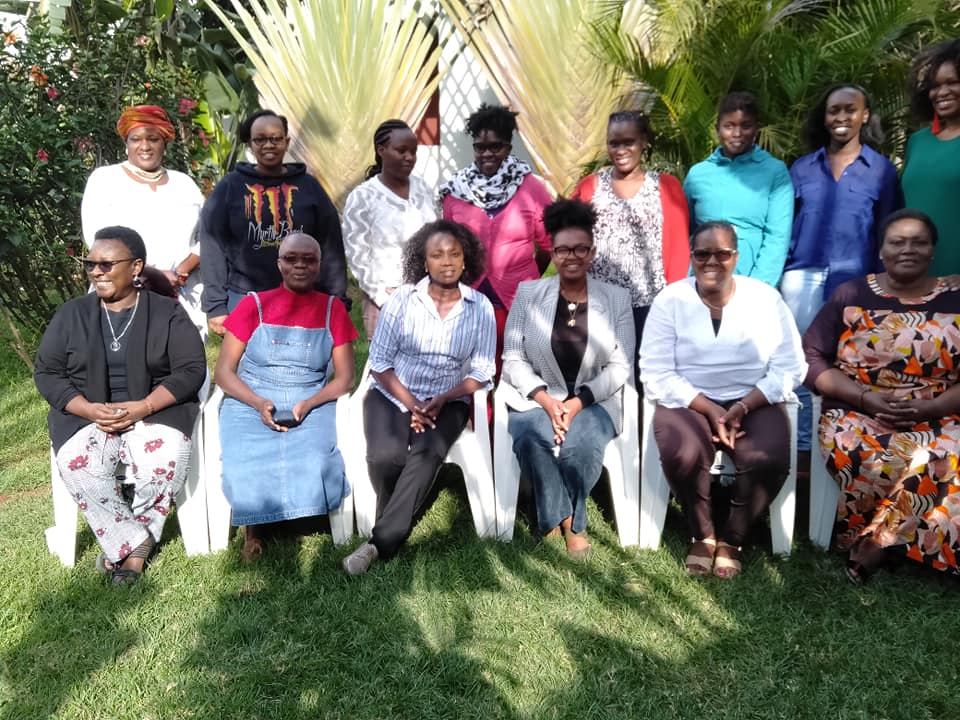
Just because it’s online does not make it any less real. Online gender-based violence has become the order of the day in Kenya. And more often than not people won’t speak about it since it’s regarded as “virtual” hence it’s not “real” violence.
But what people forget, or do not know, is that sometimes, online gender-based violence moves from online to offline. Most victims of this vice are women, especially women journalists and women politicians.
As the goal of the perpetrators is to silence women, online violence is a symptom of deep-seated gender inequality and is just one more way that women and girls are denied their human rights. It is against this backdrop that I utilised my speciality in gender digital security training to conduct the digital security training session for IAWRT-Kenya.
The highlight of the training was ‘how to create a feminist internet’, an internet where women don’t feel vulnerable being online. a safe space where women and girls are free to express themselves online without fear of being victimized. And it’s up to all of us and especially women who have a larger platform to advocate for this feminist internet. The training concluded by talking about self-care; how as journalists we should sometimes step away from the internet and take a moment to ourselves.
The Kenya chapter will work on engaging media management and policy makers to sensitize media management to the problem of online harassment that journalists face while carrying out their work. It plans to use the media to problematize and publicize the issue of journalist’s digital safety based partly around the forthcoming GMP handbook’s best practice findings.
Nepal
‘Women’s Sovereignty in Entertainment Programs’ & #MeToo advocacy for media students by Mallika Bhattarai
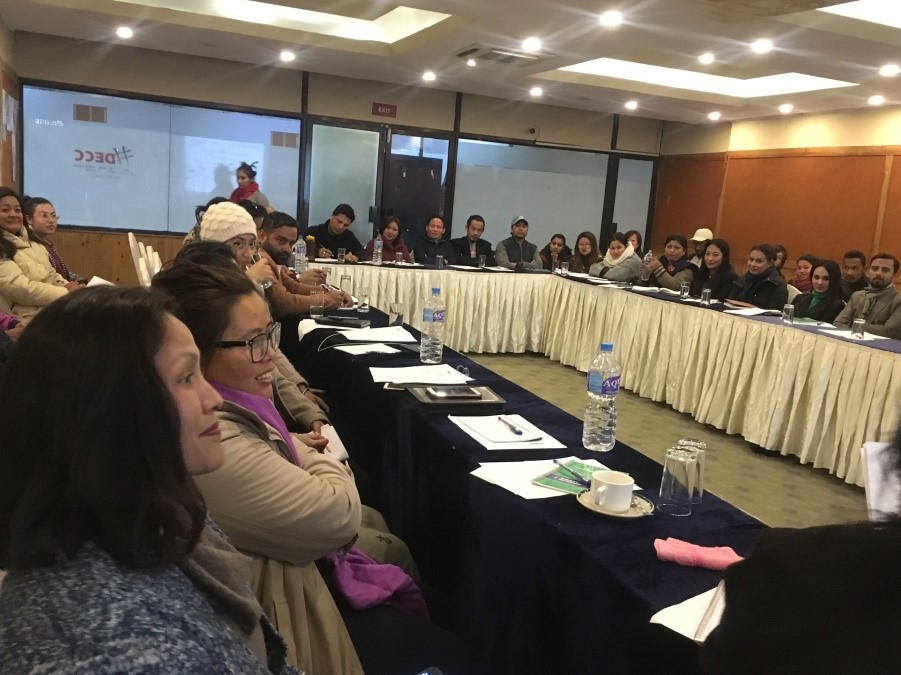 IAWRT Nepal conducted an interactive workshop on how entertainment shows are portraying female characters in mid December which was attended by directors, popular actors, script writers, producers, singers and senior media people.
IAWRT Nepal conducted an interactive workshop on how entertainment shows are portraying female characters in mid December which was attended by directors, popular actors, script writers, producers, singers and senior media people.
Senior journalist, activist and former Deputy Director of Nepal Television Deepa Gautam presented a research paper on how women are portrayed in recent popular shows and comedies on radio and Television and movies. She found that women are consistently portrayed as weak and stupid, or as an assistant to their male counterpart, who is portrayed in a position of power. Ms Gautam appealed directly to those attending, urging them to be gender sensitive and to spread gender friendly messages and action through the media they work in.
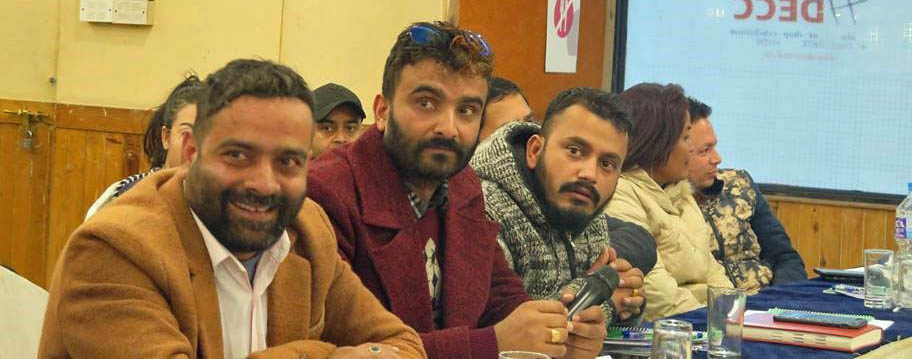 The program was facilitated by Nita Pandit, Chairperson of Sancharika Samuha, (a forum of women communicators, promoting a healthier and gender sensitive media) with Ms Montessori Rajbhandari, President of IAWRT Nepal. A number of those attending made a commitment to greater gender sensitivity on their programs after a lively discussion. We were all overwhelmed by the participants’ responses and it was a moment of pride to be a part of this great event. We hope to continue having such events that have women as the core topic and help in the empowerment of women.
The program was facilitated by Nita Pandit, Chairperson of Sancharika Samuha, (a forum of women communicators, promoting a healthier and gender sensitive media) with Ms Montessori Rajbhandari, President of IAWRT Nepal. A number of those attending made a commitment to greater gender sensitivity on their programs after a lively discussion. We were all overwhelmed by the participants’ responses and it was a moment of pride to be a part of this great event. We hope to continue having such events that have women as the core topic and help in the empowerment of women.
Be Bold for change, be bold to speak up the truth, be bold to bring out your suppressed voice
 That was the title of advocacy workshops for media students on the #MeToo campaign. held at Pentagon College and Green Field College. The aim was to make students aware of this global movement and encourage them to break the silence if they ever have had to face sexual harassment.
That was the title of advocacy workshops for media students on the #MeToo campaign. held at Pentagon College and Green Field College. The aim was to make students aware of this global movement and encourage them to break the silence if they ever have had to face sexual harassment.
Kriti Bhattarai, actress, activist, educator and media presenter, explained the history of the campaign. which took off in the United States with accusations of sexual assault against the Hollywood producer Harvey Weinstein.
 In Nepal as well, Keshav Sthapit, a former mayor of Kathmandu and a provincial minister was forced to step down, after being exposed as part of Nepal’s #MeToo movement.
In Nepal as well, Keshav Sthapit, a former mayor of Kathmandu and a provincial minister was forced to step down, after being exposed as part of Nepal’s #MeToo movement.
More than 100 students participated, and they were very keen to learn more about this movement as they shared their own experiences of facing sexual assaults in schools, temples and on public transport, especially where there are crowds. IAWRT Nepal’s GMP workshops received news coverage on national television
Philippines
Empowering women in Radyo ni Juan Mindanao newsrooms reportage and management under Duterte’s presidency By Lady Ann Salem
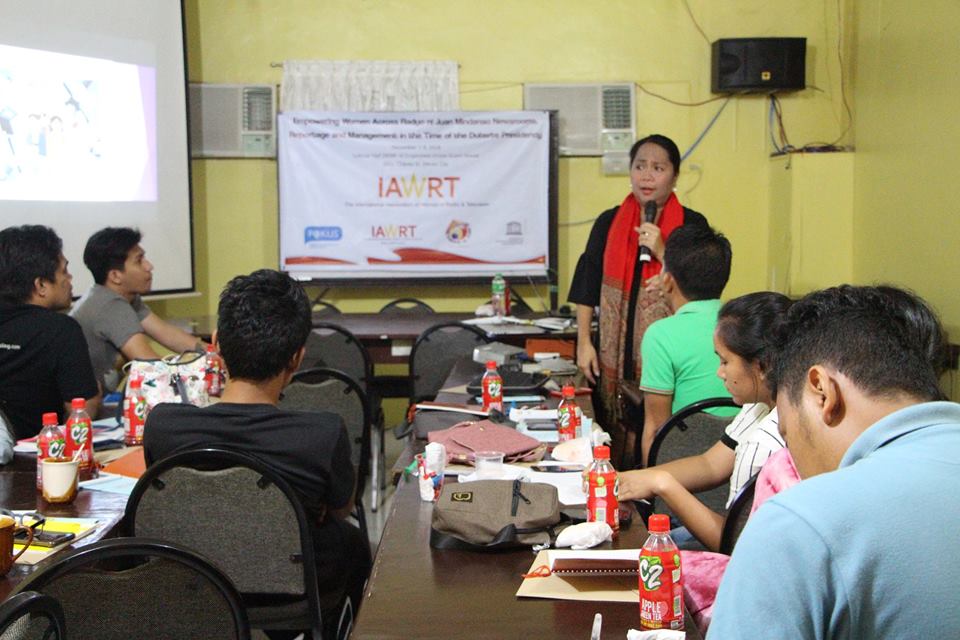
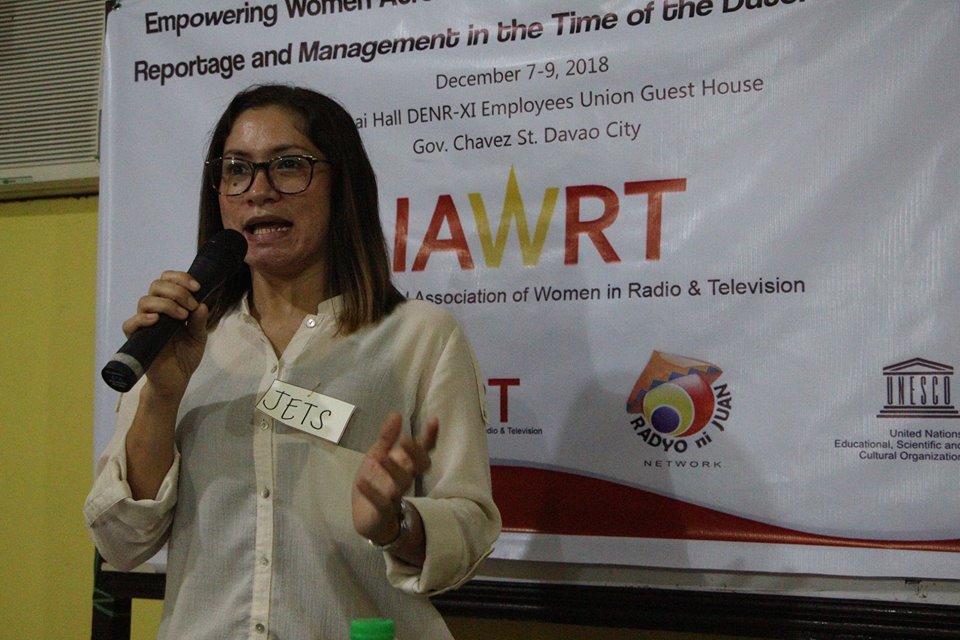 Women’s issues are people’s issues—and this is why Radyo ni Juan finds it imperative that more news airtime are allocated for women and children in its six broadcasting stations in Mindanao.
Women’s issues are people’s issues—and this is why Radyo ni Juan finds it imperative that more news airtime are allocated for women and children in its six broadcasting stations in Mindanao.
Such was the major point in the collective unities formed after the three-day training, workshop and impact assessment heldin Davao City from December 7 to 9. Radyo ni Juan’s 41 news directors, reporters, staff, managers and student observers also participated in a plenary and open forum to discuss women, gender and equality issues in its reportage and news planning priorities.
Lynda Garcia, Vice President of IAWRT Philippines Chapter, served as the keynote speaker and shared IAWRT and UNESCO’s Gender Mainstreaming Project. Jola Diones-Mamangun and Grace Uddin, IAWRT member and Radyo ni Juan Network executive vice president were facilitators.
 Germilina Lacorte, Acting Bureau Chief of Philippine Daily Inquirer Mindanao, spoke about covering women, children and adult issues under the present administration.Mario Maximo ‘Dodong’ Solis, Chief Operating Officer of Radyo ni Juan Network-Philippines, spoke about his experience on being a radio broadcaster and making a stand on people’s issues.
Germilina Lacorte, Acting Bureau Chief of Philippine Daily Inquirer Mindanao, spoke about covering women, children and adult issues under the present administration.Mario Maximo ‘Dodong’ Solis, Chief Operating Officer of Radyo ni Juan Network-Philippines, spoke about his experience on being a radio broadcaster and making a stand on people’s issues.
A solidarity night was held at the end of the activity; the participants expressed their commitment to good journalism in an unrivalled time of fake news, hate speech and troll proliferation.
|
|---|
Amplifying the People’s Voices
Amplifying the People’s Voices: The Philippine Community Radio Experience and Challenges, was launched in 2018 and is now available for download.
It narrates almost three-decades of community radio broadcasting in the Philippines, laying down the challenges it faces in one of the most dangerous countries for journalists in the world.
The 72-page book was launchedin Kampala, Uganda, by the IAWRT President, Violet Gonda and the editor and head of the Philippines Chapter Jola Diones-Mamangun in Octiber 2018.
The book chronologically narrates how community radio broadcasting began in the Philippines in the 1990s and looks at the problems it continues to face to this day. It explains how current broadcasting laws in the country make it difficult for low-power radio stations to acquire franchises and licenses from government institutions.
However, IAWRT International treasurer, Jola Diones-Mamangun, said the book is less about the campaign’s problems and more about its successes, despite overwhelming odds.
“We want this book’s readers to realize that whatever successes the community broadcasting movement in the Philippines has achieved, they are due to the communities’ determination to tell their own stories through radio,” Diones-Mamangun said.
“The lesson here is that community radio broadcasting will never happen without the communities themselves.”
AMPLIFYING THE PEOPLE’S VOICES: The Philippine Community Radio Experience and Challenges available online, in our publications


